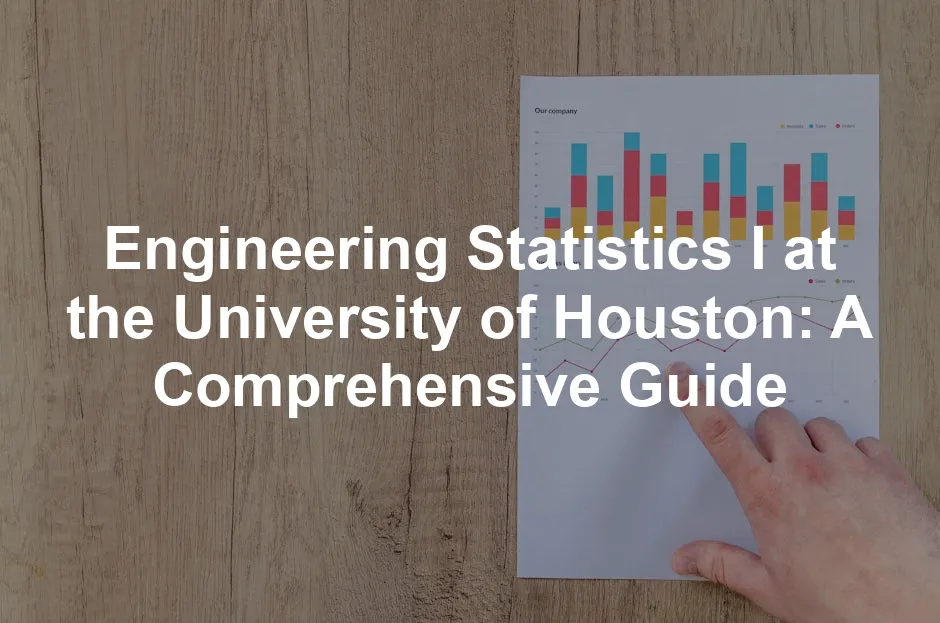Introduction
Statistics holds a significant place in the engineering world. It’s not just about crunching numbers; it’s about making informed decisions based on data. Engineers rely on statistics to analyze processes, control quality, and improve designs. Statistics is the backbone of innovative engineering solutions, allowing students to tackle real-world problems effectively.
One such course that embodies this importance is “Engineering Statistics I” (INDE 2333) at the University of Houston (UH). This course is a vital step for engineering students, providing a solid foundation in statistical methods and their applications. Before diving into the details of this course, let’s clarify the prerequisites. Students must complete MATH 2414 (Calculus II) and ENGI 1331 (Computing and Problem Solving for Engineers) before enrolling. This ensures that all students have the necessary mathematical skills to understand complex statistical concepts.
The course structure is designed to cover essential aspects of statistics relevant to engineering. It includes lectures focused on theoretical knowledge and practical applications. This combination helps students grasp key concepts while also preparing them for real-world engineering challenges.
Mastering statistics is crucial for engineering students. It equips them with the tools needed to analyze data, draw conclusions, and make decisions based on evidence. As future engineers, students will find that a strong statistical background enhances their problem-solving capabilities and ensures they can contribute effectively to their fields.
The purpose of this article is to provide a detailed overview of the Engineering Statistics I course. We will explore the course content, expectations, and available resources to help students succeed. Whether you’re considering taking this course or are already enrolled, this guide will give you valuable insights into what to expect and how to excel.

Course Overview
What is Engineering Statistics I?
Engineering Statistics I is a comprehensive introduction to statistical methods tailored specifically for engineering applications. This course covers fundamental concepts essential for analyzing data and making informed decisions. Key topics include probability, various probability distributions, and hypothesis testing.
Throughout the course, students will explore the principles of probability, a vital concept that underpins statistical analysis. Understanding probability helps engineers assess risks and uncertainties, a common scenario in engineering projects. Additionally, the course delves into different probability distributions, such as the normal, binomial, and Poisson distributions. These distributions are crucial for modeling real-world phenomena and interpreting data accurately.
Hypothesis testing is another critical aspect covered in this course. It allows engineers to make decisions based on sample data, determining whether to accept or reject a hypothesis. This skill is invaluable when conducting experiments or analyzing quality control data in engineering contexts.
In summary, Engineering Statistics I provides students with a robust foundation in statistical concepts and methods. The knowledge gained from this course will be instrumental in their engineering careers, as statistics play a crucial role in design, quality assurance, and process improvement. For a deeper understanding of the differences between engineering statistics and regular statistics, you can read more about engineering statistics I vs regular statistics.
Understanding the differences between engineering statistics and regular statistics is essential for students. Learn more about this topic here.
Course Structure
Engineering Statistics I (INDE 2333) at the University of Houston is a 3-credit hour course. It encompasses 3 hours of lecture time per week, with no lab component. This structure aims to balance theoretical learning with practical applications. Students can expect to engage in diverse statistical methods focusing on engineering contexts.
The grading system is straightforward. Performance is evaluated based on exams, quizzes, and possibly a project. This ensures that students have multiple opportunities to demonstrate their understanding of the material. Students often find this approach beneficial; it encourages consistent effort throughout the semester.
For course materials, students primarily use textbooks that cover fundamental statistical concepts. Recommended texts typically include comprehensive guides on probability and statistical methods tailored for engineering. Supplementary resources, such as online databases and statistical software like Minitab, are also encouraged to enhance learning.

Prerequisites
Before enrolling in Engineering Statistics I, students must complete two prerequisite courses: MATH 2414 and ENGI 1331. MATH 2414, also known as Calculus II, provides essential mathematical foundations. It’s crucial for understanding the calculus-based concepts that appear in statistics.
ENGI 1331 covers computing and problem-solving techniques for engineers. This course introduces students to programming and computational methods, which are invaluable when analyzing statistical data. Mastery of these prerequisites is vital for grasping the more complex statistical methods taught in Engineering Statistics I. To further bolster your programming skills, consider picking up a copy of Programming for Engineers with Python.

Key Topics Covered in Engineering Statistics I
Basic Concepts of Probability
Probability theory is a cornerstone of statistics, especially in engineering. It helps students assess risks and uncertainties. Understanding probability allows engineers to make informed decisions based on data analysis. A great resource to kickstart your understanding is the Probability and Statistics Workbook for Dummies.
In this course, students learn about different probability distributions. These include discrete distributions, such as the binomial and Poisson distributions, which deal with countable outcomes. Continuous distributions, like the normal distribution, are also covered. These concepts are vital for modeling real-world phenomena.
For instance, engineers use the normal distribution to analyze measurement errors and variations in manufacturing. The ability to apply these distributions helps students interpret data accurately and make data-driven decisions in engineering practice.
In summary, the grasp of probability and its applications is crucial for students pursuing careers in engineering. This foundational knowledge not only prepares them for more advanced topics in statistics but also equips them to tackle real-world engineering challenges effectively. If you’re interested in the broader implications of probability in genetics and statistics, check out this comprehensive guide on Mendelian genetics probability, pedigrees, and chi-square statistics.

Understanding probability in the context of genetics and statistics can provide valuable insights. Explore this topic further here.
Probability Distributions
Probability distributions are the bread and butter of statistics. They help us understand how likely different outcomes are in engineering contexts. Let’s break down some key distributions.
Normal Distribution: This bell-shaped curve is super popular. In engineering, it’s often used to model things like measurement errors and material properties. Think about the height of a group of people; most are around average height, with fewer being extremely short or tall.
Binomial Distribution: Perfect for scenarios with two outcomes, like success or failure. Engineers use it for quality control, determining the probability of a certain number of defective items in a batch. Imagine checking a dozen light bulbs and wondering how many will actually light up.
Poisson Distribution: This one shines when we’re counting events happening over a fixed interval. For instance, engineers might use it to predict how many cars pass through a toll booth in an hour. It’s all about understanding rare events, like equipment failures.
In essence, these distributions provide crucial insights for engineers, guiding decisions and optimizing processes. If you’re looking for an excellent reference, consider Probability and Statistics for Engineering and Science by Jay L. Devore.

Joint Distributions, Covariance, and Correlation
Joint distributions come into play when we want to understand the relationship between two random variables. Are they independent or correlated? That’s where covariance and correlation step in.
Joint Distribution: This describes the probability of two events happening together. For example, an engineer may analyze the relationship between temperature and pressure in a gas system. Knowing how these variables interact helps predict system behavior.
Covariance: This measures how two variables change together. If both increase, covariance is positive; if one increases while the other decreases, it’s negative. It’s like a dance—if they twirl together, they have a positive relationship!
Correlation: While covariance gives a rough idea, correlation standardizes this measure, providing a clearer picture of the strength of the relationship. A correlation close to 1 means a strong positive relationship, while -1 indicates a strong negative one. Engineers use this to validate models and refine designs.
Understanding these concepts is vital for engineers analyzing data, ensuring they make informed decisions based on reliable relationships.

Descriptive Statistics
Descriptive statistics serve as the first step in data analysis. They summarize and present data clearly and effectively, making it easier to understand complex information.
Techniques for Summarizing Data: Common methods include measures like mean, median, and mode. The mean offers the average, while the median provides the middle value, and the mode identifies the most frequent observation. These summaries help engineers grasp the overall trends in their data.
Importance in Engineering Problem-Solving: Descriptive statistics help engineers identify patterns, detect anomalies, and make quick decisions based on data. For instance, in quality control, a simple average can reveal if a manufacturing process is running smoothly or if adjustments are needed.
In short, descriptive statistics are indispensable for engineers. They condense vast amounts of information into digestible insights that guide effective problem-solving. To gain more insight into descriptive statistics specifically in manufacturing, refer to descriptive statistics in manufacturing plant.

Understanding descriptive statistics in manufacturing is vital for engineers. Learn more about this topic here.
Statistical Inference
Statistical inference is like a magic wand in engineering. It helps you make decisions based on data without needing to examine every single piece of information. One-sample statistical inference involves two main concepts: confidence intervals and hypothesis testing.
A confidence interval estimates a range in which the true population parameter lies. Imagine you’re trying to determine the average lifespan of a certain type of battery. You couldn’t test every battery in the world, right? Instead, you sample a few, calculate their average lifespan, and create a confidence interval. This interval gives you a range, say 300 to 400 hours, indicating where the true average likely falls. It’s like saying, “I’m pretty sure the average is between these two numbers, but I won’t bet my life savings on it!”
Hypothesis testing, on the other hand, is a method for making decisions about a population based on sample data. You start with a null hypothesis (the default assumption, like “this battery lasts 300 hours“) and an alternative hypothesis (like “this battery lasts longer than 300 hours“). You collect your sample data, perform statistical tests, and determine whether to reject the null hypothesis. If your sample means suggest your battery lasts longer, you might shout, “Eureka!” and accept the alternative hypothesis.
In engineering decision-making, these concepts are crucial. For instance, in quality control, engineers use statistical inference to determine whether a new manufacturing process produces items that meet quality standards. By analyzing samples and constructing confidence intervals, they can confidently decide if the process is effective or if adjustments are needed.
Statistical inference transforms raw data into actionable insights. It equips engineers with the confidence to make decisions that can save time, money, and resources. So, the next time you see engineers making decisions, remember—there’s a bit of statistical magic at play! For a comprehensive guide on statistical inference in data science, you can check out statistical inference for estimation in data science colorado.

Understanding statistical inference is crucial for engineers. Explore this topic further here.
Course Expectations and Assessment
Grading Criteria
In Engineering Statistics I, grading is designed to keep you on your toes, but don’t worry! Here’s a breakdown of how your performance will be evaluated. Typically, the course consists of exams, quizzes, and projects.
Exams usually make up about 60% of your final grade. There are usually three major exams throughout the semester. Each exam tests your understanding of the material and your ability to apply statistical methods to engineering problems.
Quizzes contribute around 20% to your grade. These quizzes are helpful for keeping you engaged with the material and ensuring you’re keeping pace with the course. They’re usually short and cover recent topics, giving you a chance to show off what you’ve learned!
Projects are where creativity meets application, accounting for about 20% of your overall grade. Students often work in groups to tackle real-world engineering problems using statistical methods. These projects not only enhance your learning experience but also teach you how to collaborate effectively—an invaluable skill in any engineering career.
To succeed in this course, stay organized and keep up with the readings. Regularly review the material covered in class. Don’t hesitate to reach out to your instructor during office hours if you have questions. Forming study groups can also be beneficial; discussing concepts with classmates helps reinforce understanding.

Attendance and Participation
Class attendance and participation are essential for success in Engineering Statistics I. When you’re present, you not only absorb the material better but also engage in discussions that deepen your understanding.
Participating in class can make a significant difference. Ask questions, share insights, and contribute to discussions. Instructors often appreciate students who actively engage, and it can lead to a more rewarding learning experience.
If you find it challenging to stay engaged during lectures, try these tips:
- Stay Prepared: Before each class, review the material that will be covered. Familiarizing yourself with concepts helps you follow along and participate actively.
- Take Notes: Writing down key points keeps your mind engaged. It also provides a valuable resource for studying later.
- Limit Distractions: Put away your phone or any other distractions. Focusing solely on the lecture will enhance your learning experience.
This course is built on a foundation of collaboration and engagement. Attend every class, participate actively, and you’ll not only learn more but also enjoy the journey of mastering engineering statistics!

Resources and Study Aids
Recommended Textbooks and Materials
When tackling Engineering Statistics I at the University of Houston, the right materials can make all the difference. Here’s a list of primary textbooks and supplementary resources that will guide you through the statistical maze.
- “Engineering Statistics” by Douglas C. Montgomery and George C. Runger – This book is a classic. It covers essential topics like probability, statistical inference, and regression, all tailored for engineers.
- “Applied Engineering Statistics” by R. Rhinehart and Robert M. Bethea – A practical approach to statistical applications in engineering. This text is loaded with real-world examples and exercises.
- “Statistics for Engineers and Scientists” by William Mendenhall, Terry Sincich – This comprehensive resource provides clear explanations and numerous examples, making it a perfect companion for the course.
Supplementary Materials:
- Online resources like Khan Academy and Coursera offer free courses on statistics and probability, which can help reinforce your understanding.
- Study guides available through the UH library can provide focused reviews on specific topics. Don’t forget to check out past exams and practice problems to familiarize yourself with the format.
- For practical applications, a Graphing Calculator (Texas Instruments TI-84 Plus) can be a game changer during exams and assignments.

Study Groups and Tutoring
Collaboration is key in mastering Engineering Statistics I. Joining a study group can be a game changer. Peer support fosters an engaging environment where you can discuss complex topics and solve problems together. Plus, explaining concepts to others helps reinforce your understanding.
At the University of Houston, several tutoring services are available. The Academic Center for Excellence (ACE) offers tutoring sessions specifically tailored for engineering courses. You can walk in with your questions or schedule a one-on-one session to dive deeper into challenging topics.
Connecting with fellow students can also lead to forming study groups. Check out bulletin boards on campus or online forums to find classmates interested in joining forces. Trust us; working together can turn statistics from daunting to doable, and you might even make some lifelong friends along the way!

Student Experiences and Reviews
Feedback from Past Students
What do students really think about Engineering Statistics I? The reviews are generally positive! Many past students rave about their instructors, especially Professor Chung. His laid-back approach makes the course more enjoyable. One student humorously noted, “You’d have to try to get a C!” This means that hard work likely results in a solid grade.
Students appreciate the practical applications of the material. Many indicate that the course prepares them well for real-world engineering challenges. Furthermore, they highlight the absence of a final exam as a significant perk. Instead, the grading focuses on projects, quizzes, and exams throughout the semester, which helps reduce stress.
However, some students caution about the pacing. “Chung goes through PowerPoints quickly,” one student commented. Staying engaged and reviewing materials regularly can help you keep up with the course flow.

Tips from Successful Students
Success in Engineering Statistics I doesn’t just come from attending lectures. Here are some tried-and-true tips from students who have aced the course:
- Stay Organized: Keep track of assignments and deadlines using a planner or digital calendar. This will help you manage your time efficiently.
- Practice Regularly: Statistics is a skill best learned through practice. Work on practice problems daily to reinforce your understanding of concepts.
- Utilize Office Hours: Don’t hesitate to seek help from your professor. Office hours are a golden opportunity to ask questions and clarify doubts.
- Form Study Groups: Collaborating with peers can enhance your learning experience. Discussing topics with others lets you see different perspectives and solutions.
- Use Online Resources: Websites like Khan Academy can provide additional explanations and practice, especially for challenging topics.
By following these strategies, you’ll not only master the material but also enjoy the process. Remember, a positive attitude and consistent effort are key ingredients for success!

Conclusion
Engineering Statistics I at the University of Houston is more than just a course; it’s a stepping stone to a successful engineering career. The knowledge gained here is invaluable. It equips students with the statistical tools needed to analyze data and make informed decisions in their future roles as engineers.
Take this course seriously! Mastering statistics will enhance your problem-solving capabilities and increase your employability. Embrace the challenge—your future self will thank you.
In a world driven by data, the ability to interpret and analyze information is crucial. The skills learned in Engineering Statistics I will not only aid you academically but will also provide a solid foundation for tackling real-world engineering problems. So, gear up for an engaging and enlightening experience in Engineering Statistics I!
FAQs
Please let us know what you think about our content by leaving a comment down below!
Thank you for reading till here 🙂
All images from Pexels




